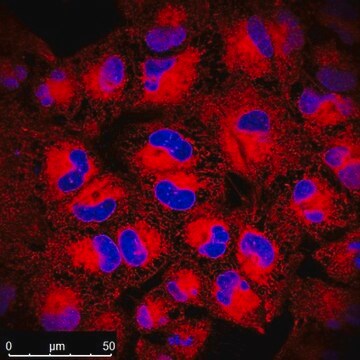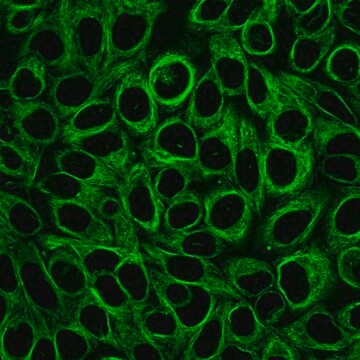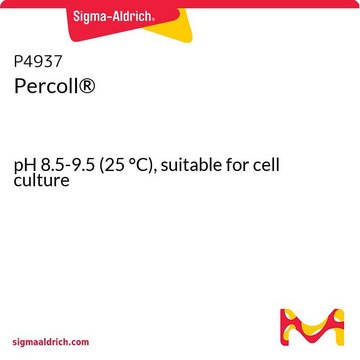17-10152
LentiBrite GFP-Vimentin Lentiviral Biosensor
About This Item
Produtos recomendados
fabricante/nome comercial
Chemicon®
LentiBrite
Nível de qualidade
técnica(s)
cell based assay: suitable
immunocytochemistry: suitable
immunofluorescence: suitable
single cell analysis: suitable
transfection: suitable
nº de adesão UniProt
método de detecção
fluorometric
Condições de expedição
dry ice
Informações sobre genes
human ... VIM(7431)
mouse ... VIM(22352)
Descrição geral
http://www.nature.com/app_notes/nmeth/2012/121007/pdf/an8620.pdf
(Click Here!)
Learn more about the advantages of our LentiBrite Lentiviral Biosensors! Click Here
Biosensors can be used to detect the presence/absence of a particular protein as well as the subcellular location of that protein within the live state of a cell. Fluorescent tags are often desired as a means to visualize the protein of interest within a cell by either fluorescent microscopy or time-lapse video capture. Visualizing live cells without disruption allows researchers to observe cellular conditions in real time.
Lentiviral vector systems are a popular research tool used to introduce gene products into cells. Lentiviral transfection has advantages over non-viral methods such as chemical-based transfection including higher-efficiency transfection of dividing and non-dividing cells, long-term stable expression of the transgene, and low immunogenicity.
EMD Millipore is introducing LentiBrite Lentiviral Biosensors, a new suite of pre-packaged lentiviral particles encoding important and foundational proteins of autophagy, apoptosis, and cell structure for visualization under different cell/disease states in live cell and in vitro analysis.
- Pre-packaged, fluorescently-tagged with GFP & RFP
- Higher efficiency transfection as compared to traditional chemical-based and other non-viral-based transfection methods
- Ability to transfect dividing, non-dividing, and difficult-to-transfect cell types, such as primary cells or stem cells
- Non-disruptive towards cellular function
EMD Millipore’s LentiBrite GFP-Vimentin lentiviral particles provide bright fluorescence and precise localization to enable live cell analysis of vimentin IF dynamics in difficult-to-transfect cell types.
EMD Millipore’s LentiBrite GFP-vimentin lentiviral particles provide bright fluorescence and precise localization to enable live cell analysis of vimentin IF dynamics in difficult-to-transfect cell types.
Aplicação
Similar to Figure 1 in the datasheet, HeLa cells were plated in a chamber slide and transduced with lentiviral particles at an MOI of 20 for 24 hours. After 24 hours, media was replaced and cells were then further incubated for 48 hours. Immunocytochemical staining (red) of the same fields of view with a monoclonal antibody against Vimentin (Cat No. MAB3400) reveals similar expression patterns to the GFP-protein (green).
Hard-to-transfect Cell Types:
Primary cell types HUVEC or HuMSC were plated in chamber slides and transduced with lentiviral particles at an MOI of 10 for 24 hours.
Confocal Microscopy Imaging:
HeLa and U2OS cells were treated as in Figure 2A in the datasheet. Images were obtained by oil immersion confocal fluorescence microscopy.
For optimal fluorescent visualization, it is recommended to analyze the target expression level within 24-48 hrs after transfection/infection for optimal live cell analysis, as fluorescent intensity may dim over time, especially in difficult-to-transfect cell lines. Infected cells may be frozen down after successful transfection/infection and thawed in culture to retain positive fluorescent expression beyond 24-48 hrs. Length and intensity of fluorescent expression varies between cell lines. Higher MOIs may be required for difficult-to-transfect cell lines.
Componentes
One vial containing 25 µL of lentiviral particles at a minimum of 3 x 10E8 infectious units (IFU) per mL. For lot-specific titer information, please see “Viral Titer” in the datasheet.
Promoter
EF-1 (Elongation Factor-1)
Multiplicty of Infection (MOI)
MOI = Ratio of # of infectious lentiviral particles (IFU) to # of cells being infected.
Typical MOI values for high transduction efficiency and signal intensity are in the range of 20-40. For this target, some cell types may require lower MOIs (e.g., HT-1080, U2OS), while others may require higher MOIs (e.g., human mesenchymal stem cells (HuMSC), human umbilical vein endothelial cells (HUVEC ), HeLa).
NOTE: MOI should be titrated and optimized by the end user for each cell type and lentiviral target to achieve desired transduction efficiency and signal intensity.
Qualidade
Informações legais
Código de classe de armazenamento
10 - Combustible liquids
Classe de risco de água (WGK)
WGK 2
Certificados de análise (COA)
Busque Certificados de análise (COA) digitando o Número do Lote do produto. Os números de lote e remessa podem ser encontrados no rótulo de um produto após a palavra “Lot” ou “Batch”.
Já possui este produto?
Encontre a documentação dos produtos que você adquiriu recentemente na biblioteca de documentos.
Artigos
High titer lentiviral particles including beta-actin, alpha-tubulin and vimentin used for live cell analysis of cytoskeleton structure proteins.
Conteúdo relacionado
Fluorescent lentiviral particles encoding important GFP/RFP fusion proteins related to autophagy, apoptosis, and cell structure that enables live cell imaging.
Nossa equipe de cientistas tem experiência em todas as áreas de pesquisa, incluindo Life Sciences, ciência de materiais, síntese química, cromatografia, química analítica e muitas outras.
Entre em contato com a assistência técnica








